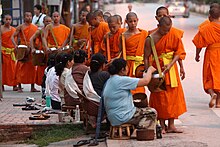Luang Prabang province
The Royal Palace, the national museum in the capital city, and the Phou Loei Protected Reserve are important sites.Luang Prabang is the ancient capital of Lan Xang ('one million elephants') and is one of the oldest cities in Laos, founded approximately 1,200 years ago.Luang Prabang was known as Muang Sua around the 11th century,[3] but the settlement's name was changed after Cambodia gave a gold image of the Buddha, the Phra Bang, as a gift.Though Chanthaphanit and his son had long reigns, the dynasty had troubles with several principalities, leading to Khun Chuang, who may have been a Kammu tribesman, extending his territory to Muang Sua and ruling from 1128 to 1170.Colonel Hans Imfeld, commissioner of the French Republic, entered Luang Prabang on 25 August 1945 with a party of Franco-Laotian guerrillas and received assurances from the king that the protectorate was still in force.[5] After the Washington Accord of 1946, the Thai government ceded the annexed territories of Luang Prabang and Sainyabuli provinces back to Laos.Notable avifauna include beautiful nuthatch Sitta formosa, Blyth's kingfisher Alcedo hercules, rufous-necked hornbill Aceros nipalensis, and yellow-vented warbler Phylloscopus cantator.[14] The Phou Loei Protected Reserve (PLI) encompassing an area of 1,465 square kilometres (566 sq mi), lies in Luang Prabang and Houaphanh provinces.[citation needed] [18] The capital city of Luang Prabang is the most notable landmark of the province and became a World Heritage Site in 1995.[19] Wat Manorom, the 6 metres (20 ft) tall, bronze, sitting Buddha, built in 1382, was badly damaged in 1887, but was renovated in 1919 and in 1971.Wat That Luang, originally established in the 3rd century BC by Ashokan missionaries, is the traditional cremation place for Lao royalty.[20] Wat Xieng Thong temple, in typical Laotian architecture, was built in the 16th century (1559–1560) during the reign of King Saysetthathirath, at the confluence of the Mekong and Nam Khan rivers.


ProvinceCountryLuang PrabangTime zoneISO 3166 codeUNESCO World Heritage SiteSessionLao textLao scriptLan Xang KingdomUNESCOWorld Heritage SiteFrench colonialRoyal PalaceWat Xieng ThongWat SenWat ManoromLao New YearLan XangMuang SawaFa NgumCambodiaSiem ReapPhra BangNan-chaoKhmer empireIndravarman IVientianeChampaKhun ChuangSiamesesuzeraintyJayavarman VIISetthathirathLuang Prabang KingdomFrancefigureheadSisavang Vonghead of stateKingdom of LaosFranco-Thai WarLan Chang provinceSainyabuliPhongsaly provinceVietnamHouaphanh provinceXiangkhouang provinceVientiane provinceSainyabuli provinceOudomxay provinceMekong RiverMassifImportant Bird AreaNam Et-Phou LoueyNational Biodiversity Conservation AreaHouaphanhmixed deciduous forestevergreen forestgrasslandavifaunabeautiful nuthatchBlyth's kingfisherrufous-necked hornbillyellow-vented warblerbamboograsslandsshifting cultivationclouded leopardleopardPhonsavanLuang Prabang DistrictXiengngeun DistrictNane DistrictPak Ou DistrictNam Bak DistrictNgoy DistrictPak Seng DistrictPhonxay DistrictChomphet DistrictViengkham DistrictPhoukhoune DistrictPhonthong DistrictAshokanBuddhaDharmachakrasGoogle MapsThe New York TimesWayback MachineĐiện Biên provinceSơn La provinceSubdivisions of LaosAttapeuBolikhamsaiChampasakKhammouaneLuang NamthaOudomxayPhongsalySalavanSavannakhetSekongXaisombounXiangkhouangDistrictsBokeo provinceHouayxayNam NhouPak ThaPha OudomTon PheungHouameuangSamtaySop BaoViengthongViengxayXam NeuaXiengkhoLuang Namtha provinceNamthaViengphoukhaChomphetNam BakPak OuPak SengPhonxayPhoukhoune